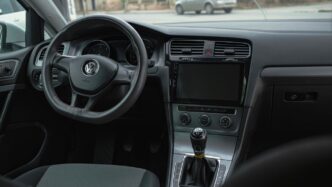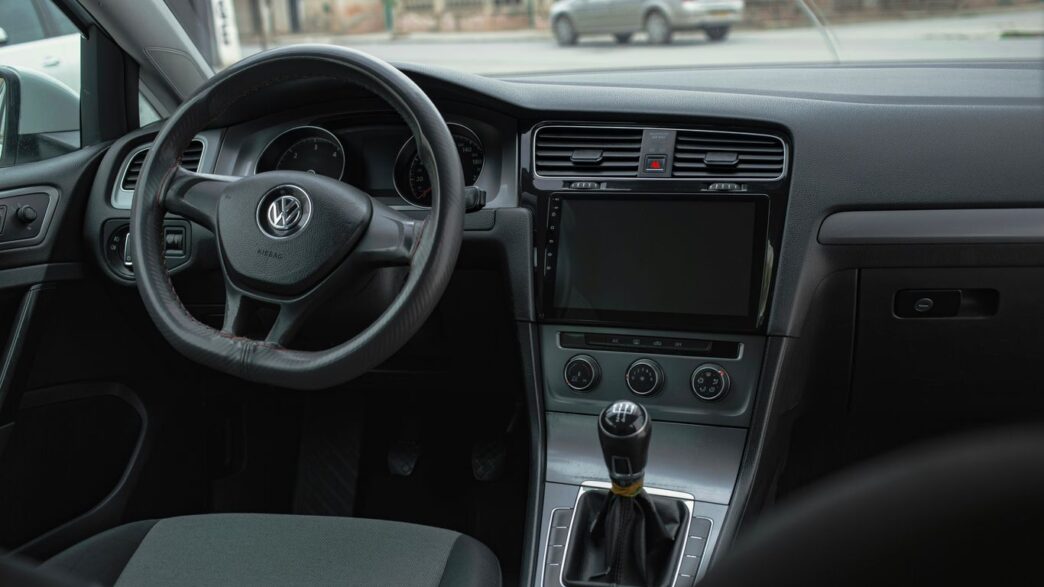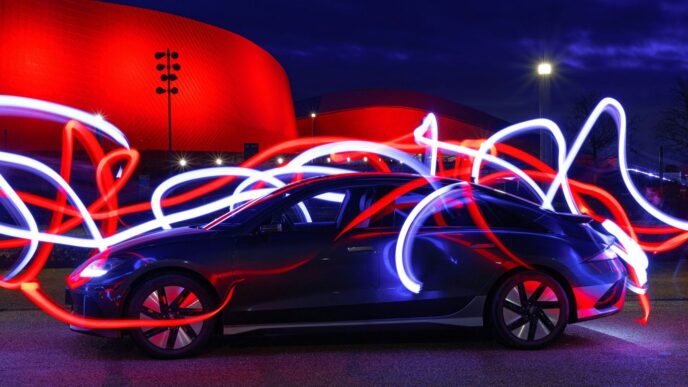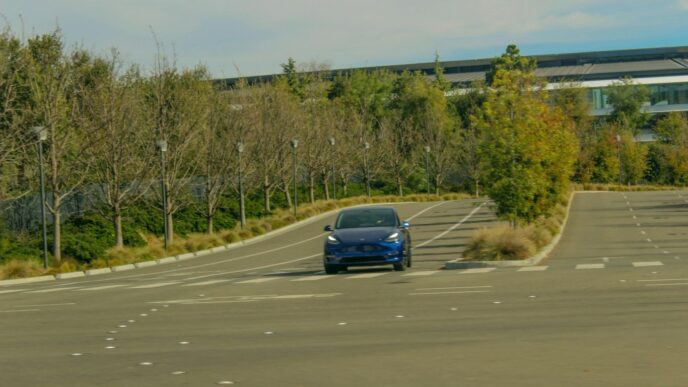Enhancing Safety Through Voice In-Car Technology
It’s easy to get distracted when you’re driving. You might glance at the GPS, fiddle with the radio, or even just think about what you need to pick up from the store. Voice in-car technology is changing that, making the whole experience safer. By letting you control things with your voice, it means your hands stay on the wheel and your eyes stay on the road. Think about it: instead of looking for a button to change the temperature or find the nearest gas station, you just say the word. It’s a pretty big deal for keeping your attention where it needs to be.
Hands-Free Operation for Reduced Distractions
This is probably the most obvious benefit. When you can just talk to your car to get things done, you’re not reaching around, looking away, or taking your mind off driving. It’s like having a co-pilot who can handle the minor tasks. This is especially helpful in busy city traffic or when you’re navigating unfamiliar roads. You can adjust the music volume, answer a call, or even send a quick text message without missing a beat.
- Less Eye Strain: You don’t need to look at screens or buttons.
- More Focus: Your attention stays on the road and surrounding traffic.
- Quicker Actions: Often, saying a command is faster than finding and pressing a button.
Voice Control for Essential Vehicle Functions
Beyond just entertainment, voice control is now managing core car functions. Need to turn on the defroster because it’s fogging up? Just ask. Want to check your tire pressure? Your voice can get you that information. This means fewer interruptions and a smoother drive, especially when conditions change quickly.
Here’s a look at how some features help:
| Feature | Benefit |
|---|---|
| Climate Control | Adjust temperature and fan speed without touching controls. |
| Navigation | Set destinations or find points of interest by speaking. |
| Communication | Make calls or send messages hands-free. |
| Vehicle Diagnostics | Get quick updates on things like fuel level or tire pressure. |
Intelligent Navigation with Voice Assistance
Navigation systems have gotten really smart. They don’t just tell you where to go; they help you get there safely and efficiently. Voice assistants can reroute you if there’s heavy traffic ahead, based on real-time information. Some systems even use augmented reality, projecting directions onto your windshield so you can see them overlaid on the actual road. This kind of smart guidance means fewer wrong turns and less time spent stressed about getting lost. It’s about making sure you reach your destination without unnecessary detours or risks.
The Evolution of Voice In-Car Interaction
Remember when car radios were the height of in-car tech? It feels like a lifetime ago. Now, our vehicles are practically rolling computers, and voice control has been a huge part of that change. It wasn’t that long ago that voice commands were pretty basic – think "Call Mom" or "Play Rock Music." You had to speak in a very specific way, and if the system didn’t understand your exact phrasing, you were out of luck. It was functional, sure, but not exactly what you’d call natural conversation.
The real game-changer has been the move towards natural language processing (NLP) and artificial intelligence (AI). This means cars can now understand a much wider range of commands, even if you don’t say them perfectly. It’s like talking to a person, not a robot. Automakers have been pouring resources into this, and you see it in systems like Mercedes-Benz’s MBUX or Tesla’s voice assistant. They’re getting really good at figuring out what you mean, even with background noise or a bit of chatter from passengers.
This shift isn’t just about convenience; it’s about making cars safer. When you can adjust the climate or change the song with just your voice, you’re keeping your eyes on the road and your hands on the wheel. It’s a big step up from fumbling with touchscreens.
Here’s a quick look at how we got here:
- Early Days: Simple, rigid command structures. Think "Radio Station 98.5." If you said "Tune to 98.5," it might not work.
- NLP Integration: Systems started understanding variations in speech. "Play some classic rock" or "I want to hear rock music" would likely yield similar results.
- AI and Machine Learning: Modern systems learn your preferences, understand context, and can even handle more complex requests like "Navigate to the nearest coffee shop that’s open now."
It’s pretty wild to think about the progress. A few years back, only a small percentage of drivers used voice tech in their cars. Now, studies show a significant chunk of us are using it regularly, and that number is only going up. It’s becoming less of a "nice-to-have" feature and more of an expected part of the modern driving experience.
Personalization and Convenience with Voice In-Car Systems
It’s pretty wild how much cars are changing, right? Beyond just getting you from point A to point B, they’re becoming these smart spaces that really get to know you. Voice tech is a big part of that, making things way more convenient and, honestly, a lot less annoying.
Tailoring Entertainment and Climate Control
Remember fiddling with tiny buttons or squinting at a screen to change the music or the temperature? Those days are fading fast. Now, you can just tell your car what you want. Want to crank up the 80s rock? "Play my 80s rock playlist." Feeling a bit chilly? "Make it warmer in here." The car listens and adjusts, keeping your hands on the wheel and your eyes on the road. It’s not just about basic commands, either. These systems learn what you like. If you always turn down the AC when you get in after work, it might start doing it for you. It’s like having a co-pilot who knows your preferences.
Seamless Smartphone Integration via Voice
Our phones are practically glued to us, so it makes sense that cars are getting better at working with them. Voice commands let you do a lot without ever touching your phone. You can ask your car to:
- Read your latest text messages aloud.
- Reply to a message with a dictated response.
- Make a phone call to a contact.
- Get directions to a place saved in your phone’s contacts.
This connection means your car becomes an extension of your digital life. You don’t have to pull over to check a notification or find a phone number. It’s all accessible through simple voice prompts, which is a huge win for convenience and safety.
Personalized User Profiles and Preferences
Think of it like logging into your favorite streaming service. Your car can now remember you. When you get in, it can recognize your voice or a quick setup and adjust everything to your liking. This includes:
- Seat position: Set it once, and the car remembers where you like to sit.
- Mirror angles: No more readjusting every time you drive.
- Climate settings: Your preferred temperature, automatically.
- Radio stations or music apps: Your go-to channels or playlists ready to go.
Some systems even learn your common routes and can suggest the best way to get somewhere based on current traffic. It’s this kind of deep personalization that makes driving feel less like a chore and more like a custom experience.
The Impact of Connectivity on Voice In-Car Capabilities

These days, cars are way more than just a way to get around. They’re becoming these super-connected hubs, and that’s a big deal for how we use voice commands. Think about it: without good connections, your car’s voice system is pretty limited. But with better connectivity, things really start to open up.
Leveraging 5G for Faster Voice Responses
Remember when you’d ask your car something and it would take ages to answer, or just give up? That’s changing, fast. 5G is a game-changer here. It’s way quicker than older networks, meaning your voice commands get sent to the cloud and back almost instantly. This speed makes talking to your car feel much more natural, like you’re having a real conversation. No more awkward pauses waiting for the system to catch up. This also means more complex requests can be handled without that frustrating delay.
Cloud-Based Intelligence for Enhanced Features
Your car’s voice system isn’t just running on a chip inside the dashboard anymore. A lot of the smarts, the actual thinking, happens in the cloud. This is where AI lives and learns. Because your car can connect to these powerful cloud servers, it can do things like:
- Understand more complicated sentences and accents.
- Access up-to-date information for navigation, like real-time traffic jams or road closures.
- Learn your habits and preferences over time to give you better suggestions.
- Connect to other services, like streaming music or making calls, without bogging down the car’s internal systems.
This cloud connection means your car’s voice capabilities can keep getting better, even after you’ve bought it. Updates can add new features or improve existing ones without you needing to do anything.
Real-Time Updates and Information Access
Connectivity also means your car is always in the loop. It can get live updates on pretty much anything that might affect your drive. This includes:
- Traffic conditions: Knowing about a slowdown ahead before you hit it. This helps the navigation system reroute you automatically.
- Weather alerts: Getting warnings about sudden storms or icy patches.
- Parking availability: Some systems can even tell you where you might find an open parking spot.
- Points of interest: Discovering new restaurants or gas stations along your route based on your preferences.
All this information, delivered instantly, makes your drive safer and a lot less stressful. It turns your car into a smart assistant that’s always looking out for you.
Future Innovations in Voice In-Car Technology
So, what’s next for talking to your car? It’s pretty wild to think about, but the tech is moving fast. We’re not just talking about telling your car to play a song anymore. The future looks like your car actually getting you, almost before you do.
Augmented Reality Integration with Voice Commands
Imagine this: you’re driving, and instead of looking down at a map or screen, information just appears right where you need it. Augmented reality (AR) is starting to blend digital info with what you see outside. Think navigation arrows painted onto the road ahead, or alerts about hazards popping up in your line of sight. You’ll be able to ask your car, "Where’s the nearest coffee shop?" and the directions will literally show up on your windshield, guiding you turn by turn without you having to glance away from the road. It’s like having a co-pilot who can draw on your view.
Predictive Features Anticipating Driver Needs
This is where things get really interesting. Artificial intelligence (AI) is getting smarter about figuring out what you might want or need next. Your car could learn your daily commute and suggest leaving earlier if it sees traffic building up. Or, if you always listen to a certain podcast on Tuesday mornings, it might just start playing it for you as you get in. Some systems are even looking at vehicle health. They can predict when a part might need attention, potentially saving you from a breakdown. It’s about the car being proactive, not just reactive.
Here’s a peek at what predictive tech might do:
- Route Adjustments: Automatically suggests a faster route based on real-time traffic and your past travel times.
- Personalized Comfort: Adjusts cabin temperature or seat position based on the time of day or your typical preferences.
- Maintenance Alerts: Notifies you about potential issues before they become serious problems, like low tire pressure or upcoming service needs.
Voice Control in Autonomous Driving Environments
When cars drive themselves, how will we interact with them? Voice will likely play a huge role. Instead of steering or pressing buttons, you might tell your autonomous vehicle, "Take me to the airport, and find a parking spot near the entrance." You could even use voice commands to adjust the cabin environment, choose entertainment, or communicate with the outside world. It’s about making the transition to self-driving cars feel natural and intuitive, keeping you in control of your journey even when the car is doing the driving. The goal is to make the car an extension of your will, controlled by your voice.
Addressing Challenges in Voice In-Car Implementation

Even with all the cool voice tech in cars these days, it’s not all smooth sailing. There are definitely some bumps in the road that car makers and we drivers have to deal with.
Ensuring Data Privacy and Cybersecurity
Think about all the stuff your car’s voice system might hear or know – where you go, what music you like, even how you talk. This information is really personal, and keeping it safe is a big deal. Automakers are working on ways to scramble this data so bad guys can’t read it, and they’re using smart computer programs to spot trouble before it happens. But hackers are always trying new tricks, so it’s like a constant game of cat and mouse to keep everything locked down.
Overcoming Compatibility and Integration Hurdles
Sometimes, the different tech bits in a car just don’t play nice together. You might have a new voice system that doesn’t quite get along with the older navigation software, or maybe your phone’s apps don’t connect like they should. It can be frustrating when things don’t work as expected. Car companies are trying to build their systems so they can be updated more easily and work with a wider range of gadgets, but it’s a tricky puzzle to solve.
Balancing Cost and Accessibility for Consumers
All this fancy voice technology doesn’t come cheap. Adding these advanced systems can drive up the price of a car, making them less affordable for some people. The goal is to make these helpful features available to more drivers, not just those buying luxury models. It’s a tough balancing act between putting in cutting-edge tech and keeping cars reasonably priced so everyone can benefit from safer, more convenient driving.
The Road Ahead: A Smarter, More Connected Drive
So, it’s pretty clear that talking to your car is no longer science fiction. From picking the perfect playlist to finding the quickest route, voice commands are making driving simpler and safer. We’re seeing these systems get smarter all the time, learning what we like and even helping out before we know we need it. While there are still things to figure out, like keeping our data safe, the direction is obvious: our cars are becoming more like helpful assistants. Get ready for a future where your car understands you, making every trip a little bit easier and a lot more enjoyable.














